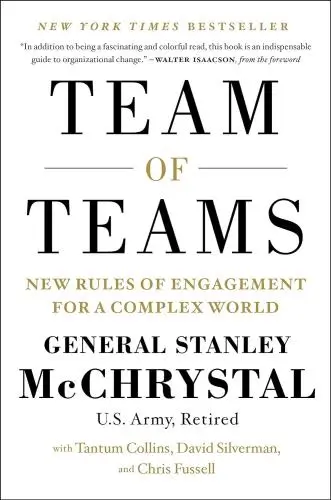The Making of a Manager
What to Do When Everyone Looks to You
What is The Making of a Manager about?
The Making of a Manager is a must-read for anyone stepping into management. Zhuo, with her firsthand experience at Facebook, unpacks the essentials of effective leadership. She demystifies management, offering practical advice and real-world examples that guide new managers through their initial challenges. From building trust with your team to making decisive moves, this book is a roadmap for navigating the complexities of leadership with confidence and integrity. Ideal for aspiring managers, it's a playbook for developing the skills to inspire and lead successfully.
About the Author
Julie Zhuo, acclaimed for her insightful book "The Making of a Manager," charms readers with her pragmatic yet warm approach to leadership and management. Zhuo's writing navigates the complexities of guiding teams with an authentic and relatable voice, making sophisticated concepts accessible to both new and seasoned managers. Her work is celebrated for distilling profound professional wisdom into engaging, actionable advice, underpinned by her own journey from a rookie manager at Facebook to a revered industry thought leader.
10 Key Ideas of The Making of a Manager
Embrace Your New Identity: Transitioning from Doer to Leader
As you step into a managerial role, it's crucial to shift your mindset from being an individual contributor to leading and guiding your team. This means focusing less on executing tasks yourself and more on empowering your team members to perform at their best. The transition involves developing a vision for your team, setting clear goals, and providing the support and resources your team needs to achieve those goals. It's about leveraging your experience and insights to guide your team rather than doing the work yourself.
Learn DeeperReflect on Your Role Daily: Spend a few minutes at the end of each day reflecting on your interactions and decisions. Ask yourself, 'Did I empower my team today?' and 'How can I better support them tomorrow?'
Set Clear Goals and Expectations: Begin by clearly defining what success looks like for your team. Break down these goals into actionable steps and communicate them clearly to each team member, ensuring they understand their role in achieving these objectives.
Foster Open Communication: Encourage your team to share their ideas, challenges, and feedback. Hold regular one-on-one meetings and team sessions to discuss progress, obstacles, and brainstorm solutions together.
Delegate Effectively: Identify the strengths and interests of your team members and delegate tasks accordingly. This not only ensures tasks are completed efficiently but also aids in the professional growth of your team members.
Provide Constructive Feedback: Offer regular, specific feedback that highlights both strengths and areas for improvement. Frame it in a way that motivates your team members to grow and excel in their roles.
- Example
A manager notices one of her team members excelling in client communications but struggling with report deadlines. She decides to delegate more client interaction tasks to this member while offering support and resources to improve time management skills.
- Example
During a team meeting, a manager sets a clear goal for the quarter: increase customer satisfaction by 20%. He breaks down the goal into specific tasks for each team member, based on their strengths, and schedules bi-weekly check-ins to discuss progress and adjust strategies as needed.
Master the Art of Effective Communication
Communication is the cornerstone of effective management. This involves not only clearly articulating your expectations and feedback but also actively listening to your team members' ideas, concerns, and feedback. Effective communication fosters a culture of transparency and trust, encourages collaboration, and helps prevent misunderstandings. It's important to tailor your communication style to suit different personalities and situations, ensuring that your message is always received as intended.
Learn DeeperPractice Active Listening: During conversations, focus entirely on the speaker. Nod, make eye contact, and occasionally paraphrase their points to show understanding. This encourages open communication and shows your team that their input is valued.
Provide Clear, Constructive Feedback: When giving feedback, be specific about what was done well and what could be improved. Use the 'sandwich' method—start with something positive, address the area for improvement, and conclude with encouragement or another positive note.
Adapt Your Communication Style: Recognize that not everyone responds well to the same communication style. Some may prefer directness, while others might need a more empathetic approach. Adjust your style based on the individual and the context of the conversation.
Encourage Open Dialogue: Create an environment where team members feel safe to express their ideas and concerns without fear of judgment. Regularly ask for their input and show genuine interest in their perspectives.
- Example
In a team meeting, instead of dominating the conversation, a manager asks open-ended questions like 'What challenges are you facing?' and 'How can I support you better?' This approach facilitates a two-way dialogue and makes team members feel heard.
- Example
When a project misses its deadline, instead of assigning blame, a manager sits down with the involved team members to discuss what went wrong. They focus on identifying lessons learned and strategies for improvement, turning the situation into a learning opportunity rather than a fault-finding mission.
Cultivate a Culture of Feedback
Creating an environment where feedback is regularly exchanged between you and your team members, as well as among peers, is essential for continuous improvement and growth. Encourage constructive criticism and recognize achievements to motivate your team. Implement regular one-on-one meetings to discuss progress, challenges, and development opportunities. This practice not only helps in identifying and addressing issues early but also strengthens relationships and builds trust within the team.
Learn DeeperSchedule Regular Feedback Sessions: Make it a point to have dedicated time slots every week or month for one-on-one meetings with each team member. Use this time to discuss their work, provide constructive feedback, and listen to their concerns or suggestions.
Create a 'Feedback is Welcome' Atmosphere: Actively encourage your team members to share their thoughts and feedback, not just in formal sessions but also in day-to-day interactions. Show appreciation for their input regardless of whether it's positive or negative.
Implement a Peer Review System: Encourage team members to review each other's work. This can be done through formal processes or more casual peer feedback sessions. It's a great way for everyone to learn from each other and foster a supportive team environment.
Lead by Example: Be open to receiving feedback yourself. Show that you value and act on the feedback you receive. This sets a positive example for your team and reinforces the culture of open communication and continuous improvement.
Recognize and Reward Constructive Feedback: When you see team members giving or receiving feedback in a constructive manner, acknowledge and reward it. This could be through verbal recognition in team meetings or through more formal reward systems.
- Example
During a one-on-one meeting, a manager discusses a recent project with a team member, highlighting what went well and areas for improvement. They then ask the team member for their perspective on the project and how they feel they can improve in the future.
- Example
In a team meeting, the manager praises a team member for their proactive approach in seeking feedback from peers before finalizing a project. This not only improved the project outcome but also encouraged others to seek out peer feedback.
Prioritize and Delegate Effectively
As a manager, you'll often find yourself juggling multiple responsibilities. Learning to prioritize tasks based on their impact and urgency is key to managing your workload effectively. Equally important is the ability to delegate tasks to your team members, taking into account their skills, interests, and developmental needs. Delegation not only helps in distributing the workload but also empowers your team members by giving them opportunities to grow and take on new challenges.
Learn DeeperAssess and Rank Tasks: Start your day or week by listing all the tasks you need to accomplish. Rank them based on their urgency and impact. Use a simple system like labeling them A (most important), B, and C (least important). This will help you focus on what truly matters.
Know Your Team's Strengths and Interests: Spend time understanding each team member's skills, interests, and career aspirations. This knowledge is crucial when you delegate tasks, as it ensures you're assigning tasks to the most suitable person, boosting both efficiency and satisfaction.
Use Delegation as a Development Tool: When delegating, consider not just who can do the task now, but who could benefit from learning how to do it. Frame it as an opportunity for growth, and provide the necessary support and resources for your team member to succeed.
Regular Check-ins for Priorities and Delegation: Have regular one-on-one meetings with your team members to discuss ongoing projects, adjust priorities if needed, and offer feedback on delegated tasks. This keeps everyone aligned and motivated.
- Example
Imagine you're leading a project with a tight deadline. You have tasks ranging from critical path activities to minor administrative work. You decide to tackle the critical path activities yourself (A tasks) and delegate the administrative work (C tasks) to a team member who has shown interest in project management and could benefit from understanding the project's administrative side.
- Example
You're managing a team responsible for delivering a software update. After ranking tasks, you identify that developing a new feature is the most urgent and impactful task (A task). Knowing one of your team members is looking to improve their coding skills and has shown interest in this area, you delegate this task to them, providing clear expectations and offering your support throughout the process.
Deeper knowledge. Personal growth. Unlocked.
Unlock this book's key ideas and 100+ more. Learn with quick, impactful summaries.
Read Full SummarySign up and read for free!
The Making of a Manager Summary: Common Questions
Experience Personalized Book Summaries, Today!
Discover a new way to gain knowledge, and save time.
Sign up for our 7-day trial now.
No Credit Card Needed

Similar Books

The Founder's Dilemmas
Noam Wasserman
Traction
Gino Wickman
Tribes
Seth Godin
Management 3.0
Jurgen Appelo
The Goal
Eliyahu M Goldratt
Only the Paranoid Survive
Andrew S. Grove
Execution
Larry Bossidy
Reinventing Organizations
Frederic Laloux
The Ideal Team Player
Patrick M. Lencioni
Multipliers
Liz Wiseman
Team of Teams
General Stanley McChrystal
The Toyota Way
Jeffrey LikerTrending Summaries

Peak
Anders Ericsson
Never Split the Difference
Chris Voss
Smart Brevity
Jim VandeHei
The Psychology of Money
Morgan Housel
The First 90 Days
Michael D. Watkins
Atomic Habits
James Clear
The Body Keeps the Score
Bessel van der Kolk M.D.
Thinking, Fast and Slow
Daniel Kahneman
The Power of Regret
Daniel H. Pink
The Compound Effect
Darren Hardy
How to Win Friends & Influence People
Dale Carnegie
Eat That Frog!
Brian Tracy
The Magic of Thinking Big
David J. Schwartz
Drive
Daniel H. Pink
Essentialism
Greg McKeownNew Books

The Millionaire Fastlane
MJ DeMarco
Losing My Virginity
Richard Branson
Venture Deals
Brad Feld
48 Days to the Work You Love
Dan Miller
Anything You Want
Derek Sivers
Running Lean
Ash Maurya
Blitzscaling
Reid Hoffman
The Founder's Dilemmas
Noam Wasserman
Founders at Work
Jessica Livingston
The Startup Owner's Manual
Steve Blank
The Art of the Start 2.0
Guy Kawasaki
The Four Steps to the Epiphany
Steve Blank
Flash Boys
Michael Lewis
Crush It!
Gary Vaynerchuk

